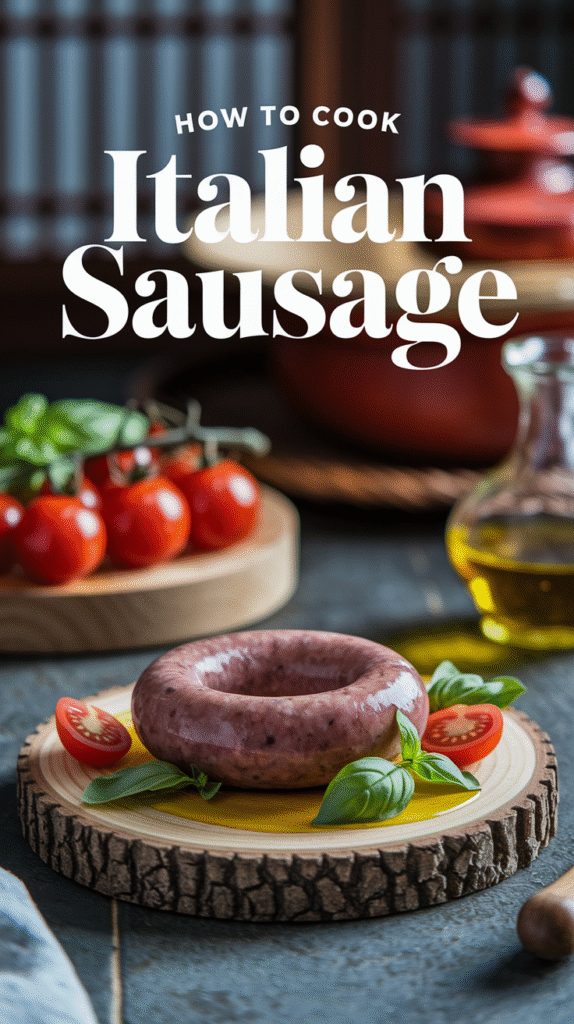Cooking Italian sausage can elevate any meal with its bold and rich flavors. Whether you’re grilling, frying, or roasting, mastering the techniques will ensure you get juicy, flavorful sausage every time. Here are some expert strategies to help you cook Italian sausage perfectly.
Choosing the Right Type of Italian Sausage
Italian sausage comes in two main varieties: sweet and hot. Sweet sausage is seasoned with herbs like fennel and has a milder flavor, while hot sausage includes red pepper or chili flakes, giving it a spicy kick. Depending on your taste preferences, choose the one that suits your dish best. For example:
- Sweet Italian Sausage: Great for pasta dishes, like spaghetti or lasagna.
- Hot Italian Sausage: Perfect for grilling or incorporating in stews for added heat.
Preparation Techniques
Before you start cooking, it’s essential to prepare the sausage properly. Follow these steps:
- Leave the Casings On: This helps retain moisture during cooking.
- Poke Holes (If Desired): For a crispier texture and reduced fat content, you can poke a few holes in the casing, but this is optional.
- Season Further: If you wish, you can add extra herbs and spices, although the sausage itself is typically well-seasoned already.
Cooking Methods
There are several methods to cook Italian sausage, each yielding delicious results. Choose one based on your preference:
Grilling
Grilling sausage adds a smoky flavor. Here’s how to do it:
- Preheat your grill to medium heat.
- Add the sausages to the grill and cook for 12-15 minutes, turning occasionally for even cooking.
- Check the internal temperature; it should reach 160°F for safe consumption.
Pan Frying
Pan-frying is quick and easy, ideal for stovetop cooking.
- Heat a tablespoon of olive oil in a pan over medium heat.
- Add the sausages and cook for 10-12 minutes, flipping them occasionally.
- If you prefer, add onions and bell peppers for added flavor.
Oven Roasting
Oven roasting provides a hands-off approach, allowing the sausages to cook evenly.
- Preheat the oven to 400°F.
- Place the sausages on a baking sheet lined with parchment paper.
- Roast for 20-25 minutes, turning halfway through until they are browned.
Enhancing Flavor
To elevate your dish, consider pairing Italian sausage with other ingredients. Here are some suggestions:
| Ingredient | Flavor Profile |
|---|---|
| Pasta | Great for creating hearty meals; toss in marinara for a classic dish. |
| Peppers and Onions | Add sweetness and a bit of crunch, perfect for sandwiches. |
| Vegetables | Pair with zucchini or eggplant for a healthy twist. |
Serving Suggestions
Once cooked, Italian sausage can be enjoyed in various ways:
- With Pasta: Toss sliced sausage with your favorite pasta and sauce.
- In a Sandwich: Serve in a hoagie roll with grilled peppers.
- As a Breakfast Item: Pair with eggs for a hearty breakfast.
Cooking Italian sausage can be easy and rewarding. For more tips and recipes, explore Food Network or visit Serious Eats for in-depth articles about preparations and varieties. Enjoy your culinary journey with flavorful Italian sausage that will make your dishes shine!
The Different Types of Italian Sausage and Their Uses
Italian sausage is a flavorful and versatile ingredient that can elevate many dishes. With various types available, each holds unique characteristics and culinary applications. Understanding the different varieties of Italian sausage can help you choose the right one for your cooking needs.
Key Types of Italian Sausage
Italian sausage can generally be categorized into two primary varieties: sweet (mild) and hot (spicy). Each type blends well with different ingredients and recipes.
Sweet Italian Sausage
Sweet Italian sausage, often labeled as “mild,” is made from pork that is seasoned with sweet spices, including fennel and sometimes sugar. This kind of sausage is known for its balanced flavors, making it great for many dishes.
Common Uses:
- Pastas: Sweet Italian sausage enhances pasta dishes like lasagna or spaghetti. Cook it with marinara sauce for a delectable combination.
- Stews: Adding this sausage to a hearty vegetable or bean stew imparts a rich flavor.
- Pizzas: It’s a popular topping for pizza, lending sweetness that contrasts beautifully with tangy tomato sauce.
Hot Italian Sausage
Hot Italian sausage features a spicier profile, often using crushed red pepper flakes in addition to the traditional spices. This type provides a kick, making it ideal for those who enjoy heat in their meals.
Common Uses:
- Grilled Dishes: Hot Italian sausage is excellent for grilling, adding a spicy punch to barbecues and gatherings.
- Sandwiches: Use it in sandwiches for a zesty, mouth-watering option. Pair it with sautéed peppers and onions for an Italian classic.
- Ragùs: This sausage brings depth to meat sauces for pastas, delivering a flavor explosion in every bite.
Other Variations of Italian Sausage
Beyond sweet and hot, there are other regional varieties of Italian sausage that bring unique flavors to the table.
| Type | Description | Common Uses |
|---|---|---|
| Capicolo | A cured meat with a delicate flavor, made from the shoulder and neck of the pig. | Great in charcuterie boards or in sandwiches. |
| Salsiccia di Cinghiale | Wild boar sausage, offering a gamey and rich taste. | Ideal for stews or classic Italian ragù. |
| Salsiccia Fresca | Fresh sausage that is often sold uncooked. | Perfect for grilling or baking into casseroles. |
Cooking Tips for Italian Sausage
To get the best flavors out of Italian sausage, consider the following tips:
- Cook Thoroughly: Always make sure the internal temperature reaches 160°F (71°C) for pork sausages.
- Remove Casings: For certain recipes, you can remove the sausage casing to create crumbled sausage for sauces or scrambles.
- Pair with the Right Ingredients: Sweet sausage works great with sweeter ingredients like bell peppers, while hot sausage goes well with bold, savory components.
Italian sausage is not just a meat product; it’s a culinary experience that transforms simple dishes into flavorful masterpieces. Whether you prefer sweet or hot, knowing the characteristics and uses of each type will help in crafting delicious meals.
For more detailed recipes and cooking tips, visit A Couple Cooks or Food Network for inspiration.
Pairing Italian Sausage with Traditional Italian Dishes
Italian sausage is a flavorful ingredient that can elevate a variety of traditional Italian dishes. With its rich seasoning and satisfying texture, it pairs well with many foods, enhancing both simple meals and elaborate culinary creations.
One of the classic pairings is Italian sausage with pasta, particularly in dishes like Italian Sausage Pasta. You can slice or crumble the sausage and sauté it with garlic, onions, and your favorite vegetables. Toss it with cooked pasta and a robust marinara sauce for a hearty meal. The sausage adds a depth of flavor that complements the tomato sauce beautifully.
Another fantastic option is to combine Italian sausage with risotto. The creamy texture of the rice dish contrasts perfectly with the spiciness of the sausage. To create a remarkable dish, cook the sausage until browned, then set it aside. In the same pot, prepare your arborio rice by sautéing onions and garlic, adding white wine, and gradually incorporating broth. Mix in the sausage towards the end of cooking for a dish that is both comforting and satisfying.
If you enjoy making pizzas at home, consider using Italian sausage as a topping. Crumbled sausage adds a savory punch. A classic pairing is sausage with roasted bell peppers, onions, and plenty of cheese. You can also try unconventional combinations, such as using sausage with kale and ricotta or even dressing a white pizza with Italian sausage for a unique twist.
Grilled Italian sausage served with sautéed peppers and onions makes for a fantastic sandwich. Use fresh Italian bread or a soft hoagie roll. To prepare, grill the sausages until they are perfectly cooked and have a nice char. Meanwhile, sauté sliced bell peppers and onions in olive oil until they are soft and caramelized. Assemble your sandwich by placing the grilled sausage on the bread and topping it with the pepper-onion mixture. This hearty meal is great for a casual gathering or weekday dinner.
For a traditional Italian appetizer, you might want to try crostini topped with Italian sausage. Begin by toasting slices of baguette until golden. In a pan, cook crumbled sausage until browned, then mix in some fresh herbs like basil or parsley. Layer the sausage mixture on top of the toasted bread and finish with a drizzle of olive oil or balsamic glaze for a delightful starter that showcases the sausage’s flavor.
Vegetable dishes can also shine when paired with Italian sausage. For instance, adding sausage to a vegetable stew adds a wonderful depth of flavor. As you simmer vegetables like zucchini, eggplant, and tomatoes, include chunks of Italian sausage to create a warming dish with layers of taste. The sausage will infuse the broth with spices, making every spoonful delicious.
Here’s a quick comparison table highlighting various dishes that pair well with Italian sausage:
| Dish | Pairing Suggestions |
|---|---|
| Pasta | Marinara sauce, vegetables |
| Risotto | Arborio rice, broth, herbs |
| Pizza | Bell peppers, onions, cheese |
| Sandwich | Sautéed peppers, onions, fresh bread |
| Crostini | Toasted baguette, herbs |
| Vegetable Stew | Zucchini, eggplant, tomatoes |
For those looking to indulge in a heartwarming meal, consider Italian sausage and lentil soup. The sausage adds a savory element and pairs well with the earthy lentils. Start by browning the sausage in a pot, followed by onions, carrots, and garlic. Add rinsed lentils and broth, allowing everything to simmer until the lentils are tender. This dish is not only nutritious but also bursting with flavor.
Italian sausage into your cooking boosts flavor and is an excellent way to explore traditional Italian culinary practices. Whether you’re creating a simple pasta dish or an elaborate stew, the use of Italian sausage brings warmth, depth, and a charming Italian feel to your meal. Consider experimenting with these pairings, and discover how versatile and delicious Italian sausage can be.
The Health Benefits and Nutritional Facts of Italian Sausage
Italian sausage is more than just a delicious addition to your favorite recipes; it also offers a range of health benefits and nutritional advantages. Made from quality cuts of pork, beef, or veal, as well as a variety of seasonings, Italian sausage comes in several forms, including sweet and spicy varieties. Understanding the nutrition of Italian sausage can help you make informed choices about how to incorporate it into your meals.
Nutritional Profile
Here is a closer look at the typical nutritional values found in a standard serving of Italian sausage (approximately 3 ounces):
| Nutrient | Amount Per Serving | % Daily Value* |
|---|---|---|
| Calories | 230 | 11% |
| Protein | 20 g | 40% |
| Total Fat | 16 g | 25% |
| Saturated Fat | 6 g | 30% |
| Cholesterol | 70 mg | 23% |
| Sodium | 580 mg | 25% |
| Vitamin B12 | 2.5 µg | 104% |
| Iron | 1.6 mg | 9% |
*Percent Daily Values are based on a 2,000-calorie diet.
Health Benefits
Italian sausage can be part of a healthy diet when consumed in moderation. Here are some notable health benefits:
- High Protein Content: One of the key nutritional benefits of Italian sausage is its high protein content. Protein is essential for building and repairing tissues, and it helps in muscle growth and overall health.
- Rich in Vitamins: Italian sausage is a great source of essential vitamins such as Vitamin B12, which is crucial for red blood cell formation and maintaining healthy nerve cells.
- Iron Source: The iron content helps in producing hemoglobin, which transports oxygen in the blood. This can be particularly beneficial for those with lower iron levels, such as vegetarians or individuals with specific dietary restrictions.
- Full of Flavor: The use of various spices not only enhances the taste but can also provide health benefits. Ingredients like garlic and fennel have antioxidant properties, contributing to overall health.
Choosing Healthier Options
Whenever possible, opt for Italian sausages that are made with lean cuts of meat and minimal additives. Look for options that are labeled as:
- Grass-fed beef or pork
- Natural or organic
- Low sodium
These options can help reduce unnecessary saturated fats and sodium in your diet while still allowing you to enjoy the rich flavor that Italian sausage offers.
Cooking Tips
To maintain the health benefits while enjoying Italian sausage, consider these cooking tips:
- Grilling or Baking: Grilling or baking sausages allows excess fat to drain away, making it a healthier cooking method.
- Add Vegetables: Combine Italian sausage with a variety of colorful vegetables in your recipes. This not only enhances the flavor but also increases the meal’s nutritional value.
- Control Portions: Be mindful of portion sizes. Enjoy Italian sausage as part of a balanced meal, ensuring it complements other healthful ingredients.
Italian sausage can be enjoyed in many forms—from pasta dishes to sandwiches. By understanding its nutritional profile and health benefits, you can incorporate it into your meals thoughtfully. For more details on healthful recipes featuring Italian sausage, explore resources such as Eat This, Not That and WebMD.
Cooking Italian Sausage: Grilling, Sautéing, and Baking Methods
Italian sausage is a flavorful addition to numerous dishes, and knowing how to cook it properly can elevate your meals. Whether you prefer grilling, sautéing, or baking, each method has its unique benefits and techniques. Below, you’ll find detailed instructions for each method to help you enjoy delicious, perfectly cooked Italian sausage.
Grilling Italian Sausage
Grilling is one of the most popular methods for cooking Italian sausage. The direct heat from the grill adds a smoky flavor, creating crispy and juicy sausages. Follow these steps for perfect grilled Italian sausage:
- Preheat your grill: Heat your grill to medium-high, approximately 375°F to 400°F (190°C to 200°C).
- Prep the sausages: If the sausages are linked, separate them to ensure even cooking. For added flavor, you can prick the sausage casings with a fork to let out excess grease (but be careful not to pierce them too much).
- Grill them up: Place the sausages on the grill. Cook for about 4-5 minutes on each side, turning occasionally, until they are browned and cooked through (internal temperature should reach 160°F or 71°C).
- Rest before serving: Let the sausages rest for a few minutes after removing them from the grill to help retain their juices.
Sautéing Italian Sausage
Sautéing is another great way to cook Italian sausage, particularly when you want to incorporate it into pasta dishes or sauces. Here’s how to sauté Italian sausage perfectly:
- Use the right pan: Select a large skillet and heat it over medium heat. A non-stick or cast-iron skillet works best.
- Add oil: Add a tablespoon of olive oil to the pan. It enhances flavor and helps prevent sticking.
- Cook the sausages: Add the sausages to the skillet and cook them for about 8-10 minutes, turning occasionally. Use a spatula to break them into bite-sized pieces for even browning.
- Check doneness: Ensure they are cooked through, checking their internal temperature with a meat thermometer.
Baking Italian Sausage
Baking is a convenient method when cooking a large batch of Italian sausages. It allows for even cooking without much attention. Here’s how to do it:
- Preheat your oven: Set your oven to 400°F (200°C).
- Prepare a baking sheet: Line a baking sheet with parchment paper or aluminum foil for easy cleanup.
- Add the sausages: Arrange the sausages in a single layer on the baking sheet, making sure they are not touching each other.
- Bake: Cook for about 20-25 minutes, flipping them halfway through. Use a meat thermometer to check for an internal temperature of 160°F (71°C).
Tips for the Best Italian Sausage
Regardless of the method you choose, here are some tips to enhance your Italian sausage cooking experience:
- Use fresh Italian sausage from a reputable butcher for the best flavor.
- Marinate sausages in herbs and spices before cooking for added zest.
- Pair cooked sausages with sautéed peppers and onions for a traditional flavor.
- Consider finishing the sausages with a glaze of balsamic vinegar or honey for a sweet and tangy twist.
Italian sausage can be used in various dishes, including pastas, sandwiches, or served on its own with sides. Each cooking method provides its unique benefits, and experimenting with different flavors and techniques can make your meals even more enjoyable.
For further recipes and tips, visit Food Network’s Sausage section and Serious Eats for more Italian sausage recipes.
Conclusion
Cooking Italian sausage can elevate any meal, bringing rich flavors and satisfying textures to your table. Understanding the various techniques and tips discussed allows you to prepare this delightful ingredient effectively, ensuring that each bite is packed with taste. With the insight into the different types of Italian sausage available, from sweet to spicy, you can choose the right variety to complement your creations perfectly.
Pairing Italian sausage with traditional Italian dishes opens up a world of culinary possibilities. Whether you’re making a classic pasta dish, a hearty pizza, or a comforting soup, the robust flavors of Italian sausage can enhance the overall taste and make any meal a crowd-pleaser. Plus, with the nutritional benefits and health facts outlined, you can enjoy your favorite recipes while being mindful of your dietary choices.
Learning the various cooking methods – grilling, sautéing, and baking – gives you the versatility to prepare Italian sausage according to your personal preference. Each technique results in a unique flavor and texture, allowing you to experiment and find your favorite way to enjoy this exquisite ingredient.
So, whether you’re whipping up a weeknight dinner or planning a weekend feast, don’t hesitate to embrace Italian sausage in your culinary endeavors. With the right techniques, pairings, and a touch of creativity, you can create memorable meals that highlight the essence of Italian cuisine while satisfying your cravings and those of your family and friends. Happy cooking!







Leave a Reply